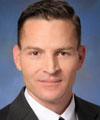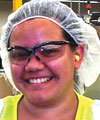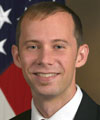2012 NSC Rising Stars of Safety
Page 4
 |
Scott May 36 Safety Coordinator Pioneer Hi-Bred International Leroy, IL |
“The three traits benefitting Scott throughout his career are his ability to listen, provide feedback and learn. Scott makes a commitment to be a part of everything going on in the plant. While being involved with our staff, he listens to their concerns, what tools they need to be successful, and assists them with developing solutions to complete the job safely.” | |
 |
Robert Neese 36 Environmental, Health and Safety Manager, Global Field and Non-operation Rockwell Automation Milwaukee, WI |
“Rob has formalized a global field safety organization with a leadership steering committee and regional business safety champions. He clarified and communicated the roles and expectations of the team. Rob also established a multi-tiered communication network, which includes annual Global Safety Management, quarterly Regional Business leaders and monthly field engineer safety meetings.” | |
 |
Maria Ortiz-Rios 38 Global Field Safety Training Manager Nalco Co. Naperville, IL |
“Maria led development and global deployment of a two-day on-boarding safety training program for new hires. This included development of an improved one-day, 12-module classroom safety awareness course and a second day of hands-on training in a real industrial environment. In the five years since development, the program has been translated into 10 languages and has expanded to 16 sites globally.” | |
 |
Joe Patterson 39 Environmental, Health and Safety Manager Formely of OraSure Technologies Inc. Bethlehem, PA |
“In 2010, Joe motivated and led a cross-functional team to develop and implement an Emergency Response Action Plan for the company. He then recruited and trained volunteers for the team and went on to implement and perform annual building evacuation drills for all three of our facilities. Joe executed safety evaluations to ensure proper placement of emergency showers/eyewashes, fire extinguishers and spill response carts, and made necessary modifications to meet OSHA requirements.” | |
 |
John Pettit 37 Assistant Vice President of Health, Environmental, and Safety VSE Corp. Alexandria, VA |
| “John initiated and led a safety initiative to positively change the safety culture from one that expected accidents and injuries as a normal part of doing business to a culture that now recognizes that every accident and injury is preventable. John champions an Integrated Process Team comprising senior management to review and analyze performance trends and statistics to collaborate and develop initiatives to enhance safety awareness of managers and employees alike. Working on this IPT, John is able to gain senior management commitment to ensure the successful deployment of all new programs while eliminating a culture of “Us and Them.” As the employees see HES and Operations working together and presenting our vision as one, there is an immediate ‘buy in’ recognized from each employee and a culture shift of ‘Safety First…Quality Always’ kept top on mind throughout the entire organization.” | |
 |
Jessica Rich 33 Safety Engineer Federal Highway Administration, Tennessee Division Nashville, TN |
“Each year, Jessica coordinates the state’s Highway Safety and Incident Management Conference, bringing together her peers to share best practices and ideas. She also re-established the Traffic Records Coordinating Committee, which has since executed several initiatives to make sure law enforcement officers and engineers have the proper access to crash records and other pertinent safety-related data in order to identify locations for safety improvements. She also has a passion for traffic safety as it relates to children and families, working with TDOT to establish the Safe Routes to School program in the state.” | |
 |
Devon Rosenfeld 35 Associate Research Scientist The Dow Chemical Co. Feedstocks and Energy Research and Development Freeport, TX |
| “Devon served as department Safety Action Committee Chairman during 2011. In this role, Devon led a group of 10 people to develop the annual goals for the department EHS program and ensured that the goals were met. During the course of the year, he facilitated monthly meetings, reviewed progress against the goals and intervened when progress was falling behind.” | |
 |
Tricia Sweat 32 Safety, Health, and Environmental Coordinator Graphic Packaging International Inc. Renton, WA |
“During the first four months on the job, Tricia led the implementation of computer-based training, shift toolbox talks, daily safety conversations, stretching and job rotation, revised incident investigation practices, a re-structured safety team, and active-aggressive incident case management practices.” | |
 |
Graham Walker 32 U.S. Army Safety Engineer Office of the Director of Army Safety Fort Belvoir, VA |
“After Army units in Europe reported hazards and accidents during training Soldiers in detecting and handling improvised and homemade explosive devices, Graham conducted research on improvised and homemade explosive device hazards and accidents at Army training locations in Europe and the United States. Having identified the risks associated with current Army improvised and homemade explosive device training practices, Graham formed a working group with explosives, combat training and safety experts across the Army to develop safe training standards for improvised/homemade explosives training and handling.” | |
 |
Cheng “Jerry” Zheng 28 Environmental, Health and Safety Engineer Mine Safety Appliances Co. Suzhou, China |
“He established a formalized safety process that included his review and applications of more than 185 EHS local and state regulations, comprehensive safety training, incident reporting investigation, weekly behavior-based safety audits, monthly/daily safety meeting routines, JSAs, and all the other special skills programs like emergency response, lockout, contractor safety, etc.” | |
 |
Troy Zimmerman 40 Americas Environmental, Health and Safety Leader Owens Corning Granville, OH |
| “After experiencing 12 recordable injuries in the first half of 2011, Troy recognized early on the need for change. He worked with operations and plant leader to develop and execute ‘the re-centering plan,’ which consisted of Hazard Identification & Control training with certifications and BBS direction change from general to very specific; ensure the ‘4 work rules’ (JHA/Standard Work – Safe Work Plan for non-routine tasks – LTT – Work permits) are active in each plant; analyze every injury to identify systemic gap; any recordable injury must be treated as if every plant in the region experienced the injury and preventive corrective actions for prevention implemented; every plant must implement three fun or engaging safety activities per quarter.” | |
Post a comment to this article
Safety+Health welcomes comments that promote respectful dialogue. Please stay on topic. Comments that contain personal attacks, profanity or abusive language – or those aggressively promoting products or services – will be removed. We reserve the right to determine which comments violate our comment policy. (Anonymous comments are welcome; merely skip the “name” field in the comment box. An email address is required but will not be included with your comment.)

